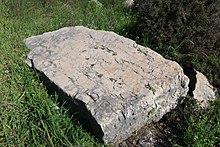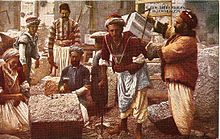Meleke
Meleke (Arabic: ملكي, "royal", "kingly"; Hebrew: אבן ירושלמית), also transliterated melekeh or malaki, is a lithologic type of white, coarsely-crystalline, thickly bedded-limestone found in the Judaean Mountains in Israel.
[3][6][7] Israeli building stone authority Asher Shadmon cites the word as one of the local or colloquial "mason's terms" that have been "adopted by geologists" and are applied in the technical literature.
[8] Meleke is quarried from the Upper Turonian Stage of the Bina (Baana) Formation of Late Cretaceous age, a layer about 10 meters in thickness and about 90 million years old.
[9] According to a long-standing legend, "Zedekiah's Cave", a large ancient meleke cave/quarry near the Damascus Gate in Jerusalem's Old City, was the source of the building material for Solomon's First Temple.
[11] Of the four types of limestone found in the Jerusalem region, two were used in building during the Islamic period in Palestine: meleke and mizzi, the latter being a harder stone, also known as "Palestinian marble".
East of St. Helena's Chapel in the Holy Sepulchre Church, the quarry was over 40 feet deep and the earth and ash therein contained Iron Age II pottery, from about the seventh century BCE.
[17] A salvage excavation conducted by the Israeli Antiquities Authority in June 2006 in the Sanhedriya neighborhood of Jerusalem exposed another ancient masonry meleke quarry.



